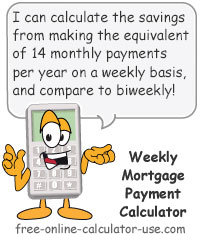IMPORTANT: Numeric entry fields must not contain dollar signs, percent signs, commas, spaces, etc. (only digits 0-9 and decimal points are allowed).
Click the Terms tab above for a more detailed description of each entry.
Step #1:
Enter either the original or the new mortgage principal amount borrowed.
Step #2:
Enter the annual interest rate of the mortgage.
Step #3:
Enter the term of the mortgage in the number of years.
Step #4:
If this is for an existing mortgage, enter the number of mortgage payments you have already made. Otherwise, if this is a new mortgage, leave this field blank.
Step #5:
If you would like to speed up the payoff of your mortgage, enter an extra amount that you could add to each weekly payment.
Step #6:
Click the "Calculate Weekly Mtg Payments" button, which will populate the payment interval comparison chart and display a chart showing the annual balance of each interval.


Follow me on any of the social media sites below and be among the first to get a sneak peek at the newest and coolest calculators that are being added or updated each month.